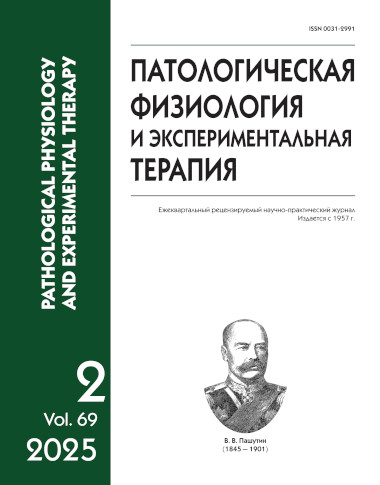Sexual dimorphism of age-related changes in the expression of α, β, and δ subunits of ATP synthase in the aorta and heart of rats: their potential impact on contractile function
Abstract
Aging is a critical risk factor for the development of cardiovascular and cerebrovascular diseases, leading to a decline in quality of life and high mortality rates worldwide. With the aging population, this situation is expected to worsen over time. Age-associated mitochondrial dysfunction is directly linked to the development of cellular senescence phenotypes. This study aimed to evaluate sex-specific early age-related changes in the expression of genes encoding the α, β, and δ subunits of the catalytic F1 domain of ATP synthase in the aorta and heart of rats and their potential impact on vascular contractile function.
Methods. Experiments were conducted on male and female Wistar rats aged 4 and 18 months. The force of contraction of the thoracic aorta was measured in an isometric mode, and gene expression was assessed using PCR analysis. Inhibitory analysis was performed using oligomycin A (an ATP synthase inhibitor) and glibenclamide (a KATP channel blocker).
Results. It was found that in the hearts of aged males, there was an increase in the expression of the Atp5f1a and Atp5f1d genes, corresponding to the α and δ subunits of the catalytic F1 domain. In the aging hearts of females, the most significant age-related changes in the expression of the Atp5f1a, Atp5f1b, and Atp5f1d genes encoding the F1 domain subunits were observed in the left atrium, which significantly differed from similar parameters in the left atrium of males (decreased instead of increased expression). A decrease in the expression of the Atp5f1b gene encoding the catalytic β subunit of ATP synthase was also detected in the left ventricle of female rats. In the aortas of aged rats of both sexes, a reduction in the expression of genes encoding the α and β subunits of the catalytic head of F1 and the δ subunit of the central stalk of ATP synthase was observed. It was shown that inhibition of ATP synthase activity using the inhibitor oligomycin A led to a weakening of the contraction force of isolated aortic rings in response to serotonin (5HT) in both young and old rats. This effect was not mediated by KATP channel activation, as the blocker glibenclamide did not influence the 5HT-induced vascular response following oligomycin A exposure.
Conclusion. The obtained results indicate early age-related changes in the expression of genes encoding the subunits of the catalytic F1 domain of ATP synthase in conduit vessels and the heart. The identified sex differences in gene expression suggest that the most significant early impairments in ATP synthesis occur in the hearts of female rats, indicating a potential for early ischemic disturbances. It is hypothesized that the high level of expression of the α subunit of the catalytic F1 domain in the aging hearts of males may serve as a compensatory mechanism to meet increased ATP demands. A substantial decrease in the expression of the α and β subunits of the F1 domain in the aortas of aged rats may negatively affect oxidative phosphorylation processes and, consequently, the regulation of vascular tone.






